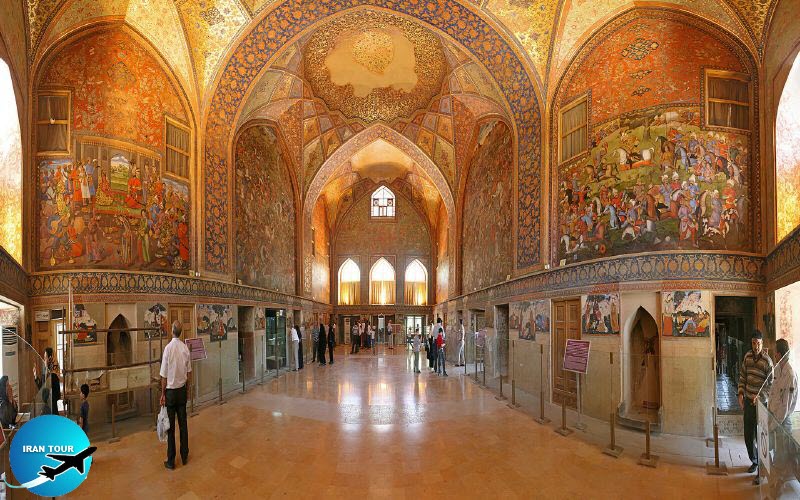Copyright 2020 - 2021 irantour.tours all right reserved
Designed by Behsazanhost
All about Chehel Sotoon Palace The most beautiful Safavid ceremonial palace
Chehel Sotoon Palace The Most Brilliant Chandelier at the Hall of the Safavid Architecture Era
In the center of Esfahan and on Ostandari Ave., one enters a heavenly garden with a five-hectare area through the eastern gate that hosts the most brilliant chandelier at the hall of the Safavid Architecture Era. In the middle of the garden Chehel Sotoon (Forty Column Palace) one of the three important existing palaces of the Safavid era, like the two others, faces an easterly direction. The palace was built primarily during the reign of Shah Abbas I, with a 'U-shaped plan, comprised of the Throne Hall and flanking rooms in the north and the southern part of its eastern side. It was expanded into the present form towards the west during the reign of Shah Abbas II, after annexations of the hypostyle (porch) and the Mirror Hall. The annexes are also on top of stone-plinth platforms, but compared with its initial part being 1.55 meters high, the level of the hypostyle is 0.9 meters higher than the garden level. It was built to function as a ceremonial palace for holding state receptions and facing a huge pool with a capacity of 3000 cubic meters.
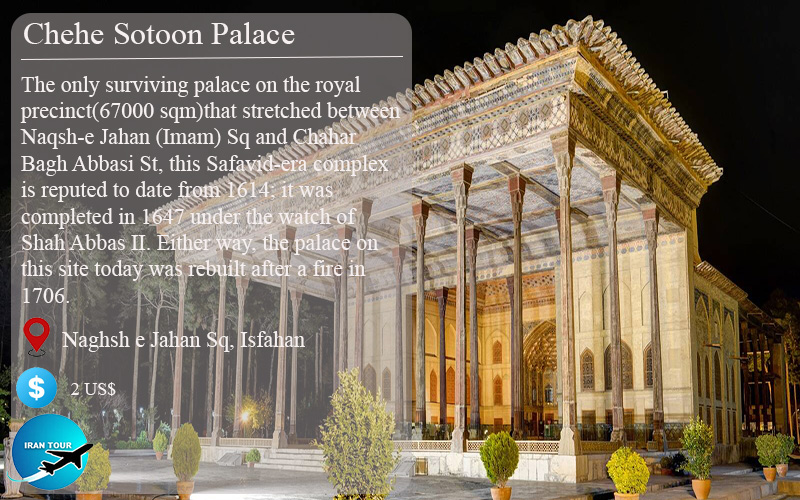 |
In the eastern part of the pool, there is a chamber particularly used by musicians with 39 square meters of area. After playing music, sound waves converged or dispersed because of the temperature differences over the pool and the long distance (its length is 110 meters) made a more dulcet quality for the audience. In addition to being a temperature moderator in all four seasons, sometimes it used to be a swimming pool for ladies in the harem after excluding outsiders.
At the four corners of the pool, four-column bases in high relief of angels (safeguarding elements) and lions (implies power and solidity) inspired
On the pool glistening bounces of mirror image,
As a touchstone verify truth than a mirage.
 |
While moving forward, the palace seems like a drop in an endless sea of creativity and enormity. Probably attention to the palace evoked Arthur de Gobineau (1855 A.D.) to state: "A city such as Esfahan was not built with such flourishing arts if the kings and the architects did not spend days and nights hearing the wonderful stories about the angels." In other words, life was inspired in the intangible spaces of those stories in the initiative minds and creative hands of builders, by a transition from a mental state to a real one to recreate some of the multicolored scenes of 'Thousand and One Night' stories in front of dazzling eyes of its visitors.
The palace covers an area of 2125 square meters (57.5 meters by 37 meters). All around it, there is a stone-paved open canal, 1 meter wide, equipped with a hydraulic system of fountains such as Ali Qapu and Hasht Behesht palaces for making the atmosphere more pleasant. The size of its hypostyle is 37 meters by 19.2 meters which covers 1/3 of the built area with 20 high-rise columns, each one 12.8 meters high, and 0.7 meters in diameter, made of one trunk of a plane tree. On the surface of the columns, there were veneers of mirror pieces. To appreciate the quality of its mirrors, a line of the poem describes them as:
So vivid one finds the image,
Evil face fits angle visage.
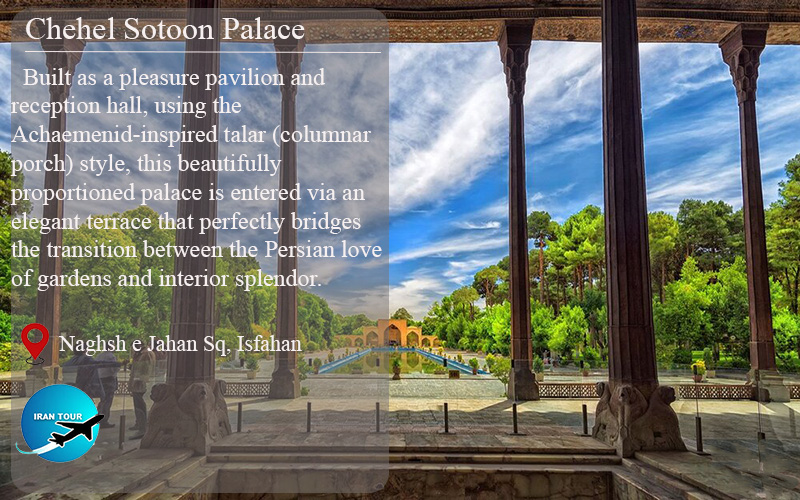 |
The palace has been restored in different stages, during the last one, it was reinforced with steel columns inside the original wooden ones, and steel cords and profiles to strengthen the damaged wooden trusses and the ceilings. However, in the restoration course, carried out in 1948 A.D., some inscribed poems revealed that indicative of a fire in the palace (1706 A.D.) and its later renovation upon the order of Shah Sultan Hussein All around the hypostyle on the level of the cornices, more than 50 small wooden-latticed windows for ventilation between the two layers of the ceiling installed. At the same level, there exist some porcelain pulleys and nails, used to hang the royal silk brocade curtains, to control temperature and extreme sunlight used.
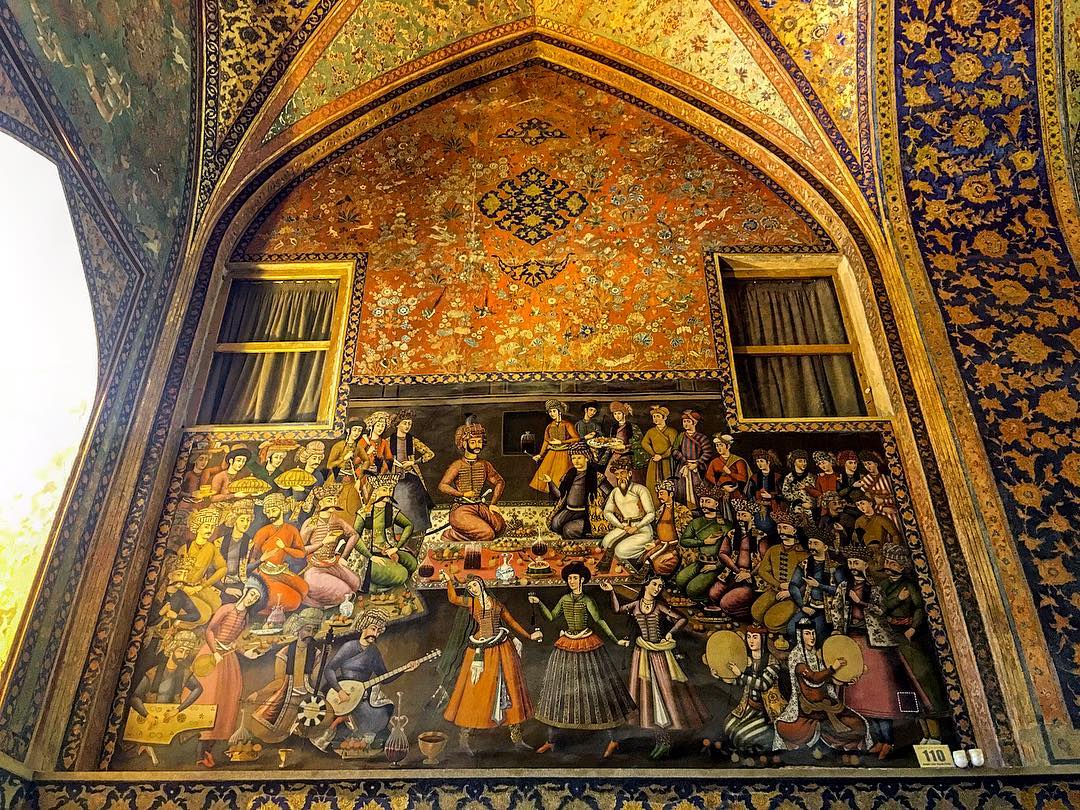 |
In the middle of the hypostyle, a marble pool with four relief column bases in the form of the body of four lions on its corner, each one measuring 1.1 meters by 1.1 meters comes into view. Although they were made of stone (because of resistance to water), the rest were not made of the same material. This disparity affirms one of the main tenets of Iranian architecture: to economize on material consumption and expenditures. To induce a kind of balanced mentality in the eyes of the visitor, a deep space on the top ceiling is designed symmetrically with a deep marble pool on the floor. For the location of the columns, the maximum endeavor was made to cause the minimum discontinuity in the space. From the structural viewpoint, the columns have also the minimum possible thickness (without buckling under the axial weight), as the supporting elements of the wooden trusses. The distance among the columns from the southeastern corner in the East-West direction is 6.2 meters, 6.6 meters, and 6.3 meters, in 6 rows, respectively. From the same origin in the north-south direction, the distance among the columns is 7.8 meters, 7.8 meters, and 6.3 meters, in 3 rows, respectively. In addition, two other columns (in the recess) supporting the main (porter) beam of the Mirror Hall, totally give the number 20 plus reflections of 20 columns on the surface of the pool, summing up the numerical denomination of 40 columns of the palace. The alternative explanation is offered for this anomaly that in Iranian culture, the number 40 indicates a sense of infinity and richness, as a Farsi poem describes it:
Man getting wise at the age of forty,
Wine getting bright on the day of forty.
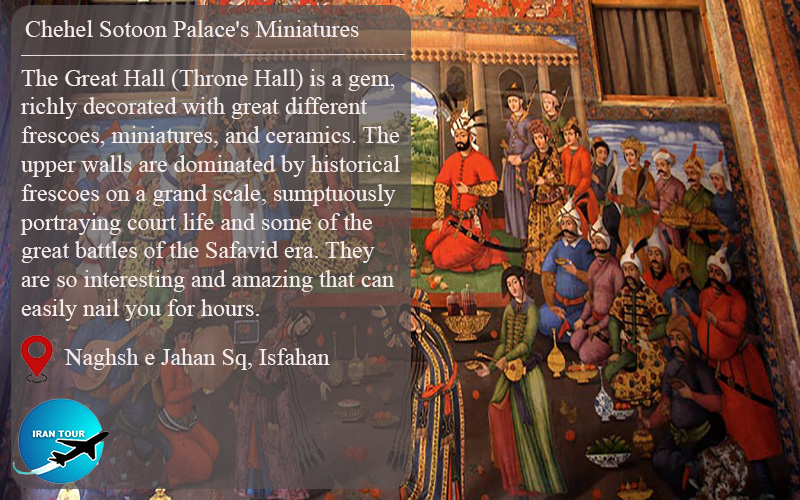 |
The Mirror Hall behind the hypostyle enjoys a rare combination of mirror wood and plasterwork on the ceiling. The mirrors are almost Venetian because of the solid evidence of printed papers from the 16th century on their back covers. No original sash windows are extant, but some new samples made of plane-tree wood without colorful glass remained. The use of this kind of window in regional architecture was for the following purposes:
1. It moderates intense sunlight and decreases mental stress.
2. By the filtration of the sun's rays, a colorful lighting system creates a fantastic atmosphere inside.
3. By analyzing the wide range frequency bands of the sunlight into some sub-bands, their radiation causes a kind of bothering on the skin of mosquitoes and spiders to keep them away.
In the Mirror Hall, a 40-square-meter platform exists, 15 centimeters high that was originally used as a pool. In addition, there is stone pavement in place of the original baked brick pavement. After entering the northern room of the Mirror Hall, which covers 72 square meters of area with a wide span of 6.2 meters and high-rise arches, one, finds the thickness of the walls about 2 meters in order to tolerate the heavy weight of the ceilings, and insulate the inner space thermally. Within the room, many murals were plastered upon the orders of Zel
Alter climbing is a relatively high step. one enters a marvelous chamber, fully covered by murals on dry plaster. On the right, a panel with twelve faces depicts a royal entertainment, wherein the defaced visage of Shah Abbas 1, is shown in the middle of the portrait. About 50 years ago, Queen Elizabeth Il, took an Esfahan and was accommodated in the chamber. amply decorated by the highest quality of Esfahani rugs and handicrafts. A little farther to the west, a glorious hall called; the Throne Room with 250 square meters (11 meters by 23 meters) of the net area located. It has a high-base arched duplex ceiling, and its lateral forces are retained by the
Built in Esfahan a ruling center,
Put heaven palaces shaming later.
|
|
There are also six large mural panels on the walls; four of them are as old as the palace and two others were painted about 150 years later. The first one on the north of the western wall, 5.7 meters by 2.2 meters in size, shows a banquet held for the governor of Turkistan Vali Mohammad Khan in 1611 A.D. with a combination of three painting genres comprised of miniature (bodies), portrait (faces) and realism done by Reza Abbasi. It attracts attention to the indoor atmosphere of the Safavid royal court. A closer inspection of Vali Mohammad's right hand reveals his hand hidden in the sleeve, showing his submission to Shah Abbas I. Next to him, is another portrait, where the character has hidden his left hand in the sleeve, indicating that he was probably the ambassador of Iran in Turkistan, and his gesture is suggestive of his loyalty to the king (the left hand implies feelings whereas the right hand implies power). The portrait of Shah Abbas I is in the middle on the right side and on his left-hand side, a group of his commanders has taken their seats. The first one with a big belly is the most faithful chief commander of the king, Allah Verdi Khan. Furthermore, some immoral scenes on the lower part of the panels (on the left the lesbians, and on the right the homosexuals) are shown.
Across the panel, another painting more or less with the same date and genre shows Shah Abbas II, and his guest, Nadar Mohammad Khan, another governor of Turkistan, who came to Iran after his enthronement to take over power again. In the top-left corner, the method of serving food in the golden-covered dishes is shown. After checking to see that they were fit to eat, they were sealed to be served safely. Although the panels have been painted in two dimensions, in the third dimension, the details of each feast can be readily felt.
 |
In the middle of the hall, on both sides, there are also two opposite panels of paintings with different styles known as the Tea House genre. The western panel shows the Chaldoran battlefield where the war between Iran (Shah Esmail I) and the Ottoman Empire (Sultan Salim) started in 1514 A.D. During the war, Iran was defeated because the Ottoman army was equipped with firearms (rifles, cannons, etc.) and outnumbered the Iranians, but the Iranian soldiers and local people. fought so bravely that Iran was safe for a couple of decades on the Western borders, and it prepared the condition for taking the initial steps to outfit with firearms. On the eastern side, another battlefield was shown between Iran and India in 1738 A.D. during the reign of Nader Shah, the king of the Afshar Dynasty, against Mohammad Gorkani (the Indian king) which came to an end when Delhi was conquered by Nader. Plenty of treasures were transferred to Iran including two unique pieces of diamonds, each one as big as an egg ("Kuh-your' and 'Darya-e-Nour'), and the Peacock Throne. On the southwestern corner of the Throne Hall, another panel with 5.9 meters by 2.2 meters dimensions, shows Homayoun, the Indian king who was deposed and took refuge in Iran (1544 A.D.) painted. After a 15-months stay in Iran, he came to power again with Shah Tahmasb's support.
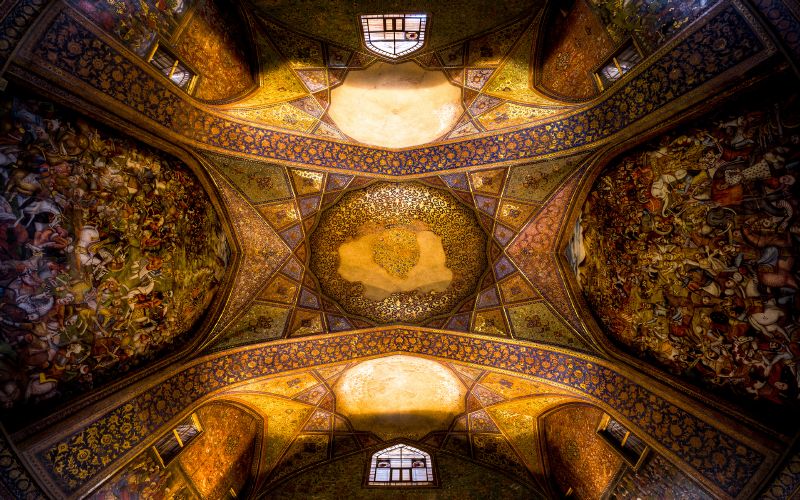 |
The sixth panel depicts the portrait of another battlefield between Iran (Shah Esmail) and the Uzbeks (Sheibak Khan), which led to the victory of Iran, although the Uzbeks were extraordinarily swift archers and riders. After this triumph, the frontiers of Iran were safe and in peace for a long time. On the ceilings, some elaborate paintings of geometric and floral designs attract attention. On both sides of the northern and southern parts, on a pale green background, there is a collection of flora and fauna of Esfahan, some are still extant and some others became extinct many years ago. In display cases, around the hall there are manuscripts, costumes, metal vessels, and the like. Two manuscripts of the Holy Qur'an on parchment exist one of them sealed by Emam Hassan's (a.s.) seal for its authenticity with a Kufic style and penmanship of Abol Barakat and 'Abol-Asvad-e-Doelli' in the 10th century, is very eye-catching. Another item that is worth mentioning is a peace-treaty scroll of the 10th century regarded as a human rights charter, between Emam Ali (a.s.) and the religious minority of Christians. To have a more comprehensive prospect about the palace, it is well worth strolling around. There are four porches on the four-direction Views. On the northern and the southern sides, four columns made O plane-tree supporting structures with 4.5 meters distance from one another, and other mural paintings show some European paintings done by two Dutch painters (Angel and Lokar) living in Esfahan, during the reign of Shah Abbas II. In general, all of the indoor and outdoor paintings were executed by Iranian artists, except the European
- Details
- Category: Museums of Esfahan
